I spent some time reading the different threads going back a few years regarding DIY alignments. There's so many differing opinions it's hard to figure out how to approach this.
I'm replacing outer tie rod ends on my '96 Grand Prix, and also putting new tires on. Old tires wore fine, so I'm looking to just get the toe in spec on the front end.
The string line attached to jack-stands method seems easiest to me and makes the most sense, and I have the tools for this. Is the idea to get the front wheels parallel with the rear wheels? Or do the front tires just need to be parallel with each other? I assume measurements need to be taken with the car on ground and suspension loaded. If someone can give a quick rundown of how this procedure is done, I'd appreciate it.
I'm absolutely not taking this to an alignment place, so there's no point in comments about the wisdom of taking it to a professional.
I'm replacing outer tie rod ends on my '96 Grand Prix, and also putting new tires on. Old tires wore fine, so I'm looking to just get the toe in spec on the front end.
The string line attached to jack-stands method seems easiest to me and makes the most sense, and I have the tools for this. Is the idea to get the front wheels parallel with the rear wheels? Or do the front tires just need to be parallel with each other? I assume measurements need to be taken with the car on ground and suspension loaded. If someone can give a quick rundown of how this procedure is done, I'd appreciate it.
I'm absolutely not taking this to an alignment place, so there's no point in comments about the wisdom of taking it to a professional.


